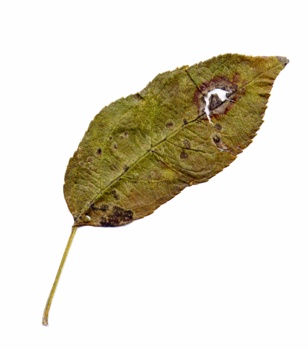Diseases
Alternaria mali Roberts - Alternaria Blotch of Apple
Systematic position.
Alternaria mali Roberts belongs to division Deuteromycota, class Hyphomycetes, order Hyphomycetales, family Dematiaceae.Biological group.
Biotroph.Morphology and biology.
Alternaria Blotch is observed on leaves and fruits. Lesions appear first on the leaves in late spring or early summer as small, round, purplish or blackish spots, gradually enlarging, with a brownish purple border. Lesions may coalesce or undergo a secondary enlargement and become irregular and much darker. Conidia are olive-brown, club-shaped, 18-55 microns long and 5-12 microns wide, with 3-8 transverse septa and sometimes with only one longitudinal septum, located in 1-3 transverse chambers. Conidia are positioned mostly in short, or moderately long chains of 3-10. The fungus can over-winter as mycelium on dead leaves, in mechanical injuries on twigs, or in dormant buds. Primary infection takes place about one month after petals fall. The disease spreads further by conidia with the help of wind, rain, or insects.Distribution.
Alternaria Blotch of Apple was registered in Krasnodar Territory, the Far East, Alma-Ata area of Kazakhstan, and Moldova. It was previously determined to be a saprotroph, being registered since 1999 as a potentially dangerous disease of apple in Krasnodar Territory.Ecology.
The disease advances rapidly at the optimum temperature of 25-30.C in wet weather.Economic significance.
When severe, Alternaria blotch of apple causes premature falling of leaves. The affected tissue of fruit becomes cork-like, and fruits become ugly. In the territory of the former USSR epiphytotic development of Alternaria Blotch has not yet been registered.Reference citations:
Ablakatova A.A. 1965. Mycoflora and the basic fungal diseases of fruit plants of the south of the Far East. Moscow-Leningrad: Nauka. 146 p. (In Russian)Gagkaeva T.Yu., Livitin M.M. 1999. Alternaria Blotch-new dangerous disease in the south of Russia. Agro XXI. N. 10. Moscow: Agrorus. 12-13 p. (In Russian)
Gagkaeva T.Yu., Levitin M.M. 2000. Identification of the pathogen causing leaf spots on apple trees in Krasnodar orchards. Mycology and Phytopathology; St. Petersburg: Nauka; 34(3): 58-61. (In Russian)
James P.W., Hawksworth D.L. 1971. Ainsworth & Bisby.s dictionary of the fungi. 6th edition. CAB, Kew. 663 p.
© Bilder I.V.


